A Study on the Motion Behavior of Metallic Contaminant Particles in Transformer Insulation Oil under Multiphysical Fields
Abstract
:1. Introduction
2. Kinetic Simulation Analysis of Metallic Impurity Particles in Flowing Insulation Oil
2.1. Kinetic Analysis of Metallic Impurity Particles
2.2. Analysis of Solid–Liquid Two-Phase Flow
3. Finite Element Simulation Model of Metal Particle Movement
3.1. The Establishment of the Simulation Model
3.2. Adding a Physical Field
3.2.1. Current Field
3.2.2. Fluid Field
3.2.3. Fluid Flow Particle Tracking
4. Analysis of Movement Characteristics of Metallic Impurity Particles in Flowing Insulating Oil
4.1. Effect of Electric Field Distribution on Motion of Metallic Impurity Particles
4.2. Effect of Electric Field Intensity on Motion of Metallic Impurity Particles
4.3. The Effect of Voltage Type on the Movement of Metallic Impurity Particles
4.4. The Effect of Particle Size on the Movement of Metallic Impurity Particles
4.5. The Effect of Oil Flow Velocity on the Movement of Metallic Impurity Particles
4.6. Effect of Dynamic Viscosity of Insulating Oil on Movement of Metallic Impurity Particles
5. Conclusions
- (1)
- The motion paths of metallic impurity particles are obviously different under different electric field distributions. Under the action of an electric field, the particles will move towards the high-field-intensity region, and the motion process under the plate electrode is relatively stable and regular, while the velocity fluctuation is small. When a particle is close to the surface of the ball electrode, its motion velocity is higher, but when it is far away from the surface of the ball electrode, the motion velocity decreases. The motion velocity of particles under the pin–plate electrode changes the most, and particles will move towards the tip of the needle after colliding with the plate electrode.
- (2)
- In an alternating current field, metallic impurity particles generally do not collide with the electrode. However, as the electric field intensity and particle size increase, the trajectories of the metallic impurity particles between the electrodes become denser, resulting in more frequent collisions between the particles and the electrodes, as well as higher motion speeds. At higher oil flow velocities, the number of collisions between metallic impurity particles and the electrode decreases, which reduces the likelihood of particle agglomeration.
- (3)
- When the temperature of the insulation oil changes and the quality deteriorates, its dynamic viscosity will change. With the decrease in the dynamic viscosity of the insulation oil, the movement of the metallic impurity particles between the electrodes is denser, the collision times between the particles and the electrodes increases, and the maximum motion speed of the particles becomes higher.
- (4)
- Through the analysis of the particle motion characteristics, it can be concluded that particle accumulation occurs readily in the non-uniform high-field-intensity region, and the possibility of particle accumulation is greatly reduced in the AC electric field environment. At the same time, in order to avoid the accumulation of impurity particles to form a small bridge of impurities, it is necessary to avoid significant agglomeration of impurity particles while at the same time increasing the oil flow rate appropriately and choosing a reasonable dynamic viscosity for the insulation oil. Therefore, it is necessary to monitor the oil quality and take certain filtration and purification measures to filter out large particles of impurities in time to avoid the accumulation of impurity particles to ensure the insulation performance of the oil.
- (5)
- This paper mainly focuses on the analysis of the vertical channel model, and in transformers, the horizontal channel model is also very common. At the same time, this paper only takes a single particle as its research object in the model. In the current research, although various models for the force in the electric field are developed, it remains a problem that the understanding of the charging process of particles is not sufficiently thorough. The charging mechanism of particulate matter in oil is complex, and the influencing factors are diverse. Even in a constant electric field environment, when there are multiple particles, there are also secondary charging and charge transfer phenomena due to particle flow collisions and interactions between particles, which usually manifest as dynamic processes, and the time-variable characteristics are more obvious in an AC field or transient field. Therefore, the question of how to fully consider the dynamic characteristics of the particle flow itself and establish a time-variable charge model with more details is a topic for future research. In subsequent studies, this model will continue to be enriched, taking into account the interactions between particles, focusing on the correlation characteristics of particle clusters, and analyzing the vertical and horizontal channels separately.
Author Contributions
Funding
Institutional Review Board Statement
Informed Consent Statement
Data Availability Statement
Acknowledgments
Conflicts of Interest
References
- Tang, J. Basic Research on Preventing Power Grid Power Outage caused by Internal Insulation Fault of substation Equipment. High Volt. Technol. 2012, 38, 1281–1291. [Google Scholar]
- Lu, W.; Liu, Q. Effect of cellulose particles on impulse breakdown in ester transformer liquids in uniform electric fields. IEEE Trans. Dielectr. Electr. Insul. 2015, 22, 2554–2564. [Google Scholar] [CrossRef]
- Dan, M. Study on the Influence of Impurity Particles on the Insulation Properties of Mineral Oil and Vegetable Oil. Master’s Thesis, Chongqing University, Chongqing, China, 2019. [Google Scholar] [CrossRef]
- Zainoddin, M.H.S.; Zainuddin, H.; Aman, A. Investigation of bridging phenomenon in ester oils contaminated with cellulose particles. In Proceedings of the International Conference on Power, Energy, and Communication Systems (IPECS), Perlis, Malaysia, 24–25 August 2015. [Google Scholar]
- Hosier, I.L.; Vaughan, A.S. Effect of particulates on the dielectric properties and breakdown strength of insulation oil. In Proceedings of the 2017 IEEE Electrical Insulation Conference (EIC), Baltimore, MD, USA, 11–14 June 2017; pp. 376–379. [Google Scholar]
- Zhang, G.; Wang, L.; Yan, W.; Deng, G.; Lu, C.; Liu, X.; Huang, Y.; Zhang, X. Characterization of discharge associated with fiber particle aggregation in oil streams under high voltage direct current field. IEEE Trans. Dielectr. Electr. Insul. 2024, 1. [Google Scholar] [CrossRef]
- Liao, R.J.; Tang, C.; Yang, L.J.; Feng, Y.; Sun, C.X. Influence of the copper ion on aging rate of oil–paper insulation in a power transformer. IET Electr. Power Appl. 2009, 3, 407–412. [Google Scholar] [CrossRef]
- Yao, Y.; Pan, C.; Tang, J.; Luo, X.; Xia, S. Study on the Motion and Partial Discharge Characteristics of Metal Particles in Fluid Transformer Oil under AC/DC Combined Voltage. Trans. China Electrotech. Soc. 2021, 36, 3101–3112. [Google Scholar]
- Wang, X.; Wang, Z.D. Particle effect on breakdown voltage of mineral and ester based transformer oils. In 2008 Annual Report Conference on Electrical Insulation and Dielectric Phenomena; IEEE: Piscataway, NJ, USA, 2008; pp. 598–602. [Google Scholar]
- Wang, S.; Shi, J.; Wang, J.; Shao, J. Effect of large particle impurities on Partial Discharge of Transformer Oil. High Volt. Technol. 1994, 20, 26–29. [Google Scholar]
- Wang, X.; Wang, Z.D.; Noakhes, J. Motion of conductive particles and the effect on AC breakdown strengths of esters. In Proceedings of the 2011 IEEE International Conference on Dielectric Liquids, Trondheim, Norway, 26–30 June 2011; pp. 1–4. [Google Scholar] [CrossRef]
- Krins, M.; Borsi, H.; Gockenbach, E. Influence of carbon particles on the breakdown voltage of transformer oil. In Proceedings of the 12th International Conference on Conduction and Breakdown in Dielectric Liquids, ICDL’96, Roma, Italy, 15–19 July 1996; pp. 296–299. [Google Scholar]
- Fu, S.; Wang, S.; Wang, J. Calculation of motion path of conducting particles in Transformer Oil. Mod. Electr. Power 1999, 16, 30–37. [Google Scholar]
- Zhang, J.; Wang, F.; Li, J.; Ran, H.; Huang, D. Influence of copper particles on breakdown voltage and frequency-dependent dielectric property of vegetable insulating oil. Energies 2017, 10, 938. [Google Scholar] [CrossRef]
- Birlasekaran, S. The measurement of charge on single particles in transformer oil. IEEE Trans. Electr. Insul. 1991, 26, 1094–1103. [Google Scholar] [CrossRef]
- Denegri, G.B.; Liberti, G.; Molinari, G.; Viviani, A. Field-enhanced motion of impurity particles in fluid dielectrics under linear conditions. IEEE Trans. Electr. Insul. 1977, EI-12, 114–124. [Google Scholar] [CrossRef]
- Molinari, G.; Viviani, A. Analytical evaluation of the electro-dielectrophoretic forces acting on spherical impurity particles in dielectric fluids. J. Electrost. 1978, 5, 343–354. [Google Scholar] [CrossRef]
- Asano, K.; Choi, C.; Kamiya, M.; Yatsuzuka, K. The behavior of a spherical particle under non-uniform electric field in silicone oil. In 2000 Annual Report Conference on Electrical Insulation and Dielectric Phenomena (Cat. No. 00CH37132); IEEE: Piscataway, NJ, USA, 2000; Volume 1, pp. 73–76. [Google Scholar]
- Wang, Y.; Li, X.; Li, Y.; Wei, C.; Lu, Y. Distribution of Copper particles in oil and Its Effect on Breakdown Characteristics of insulating oil under AC-DC Combined Voltage. Trans. China Electrotech. Soc. 2018, 33, 5581–5590. [Google Scholar]
- Li, X. Effect of Temperature on Discharge Characteristics of Metal Particles in Flowing Oil. Master’s Thesis, Chongqing University, Chongqing, China, 2017. [Google Scholar]
- Lai, C.D.; Xie, M. Stochastic Ageing and Dependence for Reliability; Springer Science & Business Media: New York, NY, USA, 2006. [Google Scholar]
- Zhang, G.; Yan, W.; Zhang, X. Influence of fiber particles on DC breakdown characteristics of transformer oil. In Proceedings of the 2022 IEEE 5th International Electrical and Energy Conference (CIEEC), Nangjing, China, 27–29 May 2022; pp. 1671–1676. [Google Scholar]
- He, B.; Wang, P.; Wu, K.; Hu, X.; Yang, D. Review on kinetic behavior of impurity phase in contaminated insulation oil in multiple physical fields. Trans. China Electrotech. Soc. 2022, 37, 266–282. [Google Scholar]
- Li, G.; Liang, X.; Wei, Y.; Su, G.; Lei, Q. Study on Effect of Defect Type and Position of Composite insulation Interface of Distribution Cable Accessories on electric field Distribution. Trans. China Electrotech. Soc. 2022, 37, 2707–2715. [Google Scholar]
- Pu, Z.; Wang, Z.; Shi, X.; Zhou, C.; Li, P.; Wu, T.; Fang, C. Motion and Distribution of combustion particles in gap under DC Voltage. Trans. China Electrotech. Soc. 2020, 35, 612–619. [Google Scholar]
- Wang, Y.; Yuan, Y.; Li, J.; Yang, L.; Li, Y. Weibull Hybrid Evaluation Model for Oil-paper Insulation Reliability of Transformer. High Volt. Technol. 2010, 36, 842–848. [Google Scholar]
- Ishii, M.; Hibiki, T. Thermo-Fluid Dynamics of Two-Phase Flow; Springer Science & Business Media: New York, NY, USA, 2010. [Google Scholar]
- Gidaspow, D. Multiphase Flow and Fluidization: Continuum and Kinetic Theory Descriptions; Academic Press: New York, NY, USA, 1994. [Google Scholar]
- Zheng, Z.; Zhuoli, X. Numerical simulation of fluid-solid two-phase flows. CIESC J. 2001, 52, 1. [Google Scholar]
- Wang, N. Research on Resistance Characteristics and Structural Improvement of Transformer with Vertical Oil Passage. Master’s Thesis, Dalian University of Technology, Dalian, China, 2018. [Google Scholar]
- Li, Y.-L. Motion Characteristics of Solid Particles in Insulating Oil and Their Effect on Breakdown Strength of Insulating Oil. Master’s Thesis, Chongqing University, Chongqing, China, 2018. [Google Scholar]
- Liu, C.; Zhao, T.; Sun, Y.; Wang, X.; Cao, S. Dynamic behaviour of a suspended bubble and its influence on the distribution of electric fields in insulating oil of an on-load tap-changer within power transformers. Int. J. Electr. Power Energy Syst. 2023, 145, 108680. [Google Scholar] [CrossRef]
- Wang, G.; Wang, W.H.; Deng, J.F.; Gao, Q.F.; Zhang, Y.X.; Bao, S.Y.; Zhu, X.J.; Gou, N.N. Numerical Simulation and Flow Characteristic Analysis of Labyrinth Control Valve. In Technological Advancement in Mechanical and Automotive Engineering; Springer: Singapore, 2021; pp. 753–764. [Google Scholar]
- Ma, S. Study on the Characteristics and Influencing Factors of Partial Discharge Produced by Metal Particles in Insulating Oil under Flowing State. Ph.D. Thesis, Chongqing University, Chongqing, China, 2017. [Google Scholar]
- Yang, H.-J.; Yan, D.-R.; Shi, G.; Han, W.; Ma, R. Modeling the correlation between oil flow rate and temperature field of oil-immersed Transformer. J. Electr. Power Sci. Technol. 2017, 32, 140–144. [Google Scholar]
- Liao, R.; Wang, J.; Yuan, Y.; Gao, F.; Li, J. Review on characteristics of new cellulose insulating paper under converter transformers. Trans. China Electrotech. Soc. 2016, 31, 1–15. [Google Scholar]
- Wang, Y.Y.; Li, Y.L.; Wei, C.; Zhang, J.; Li, X. Copper particle effect on the breakdown strength of insulating oil at combined AC and DC voltage. J. Electr. Eng. Technol. 2017, 12, 865–873. [Google Scholar] [CrossRef]
- Wu, H.; Qi, B.; Li, C.; Zhao, X.; Zhao, L.; Lv, J.; Sun, X.; Zhao, Y. Ac-dc Composite Electric Field measurement of oil-paper Composite insulation based on Kerr effect method. J. Electr. Eng. Technol. 2013, 28, 28–34. [Google Scholar] [CrossRef]
- Su, M.; Li, C.; Xia, G.; Wu, J.; Gao, B.; Yang, Y. Study on partial discharge characteristics of oil paper insulation at different oil flow speeds. New Technol. Electrotech. Eng. 2019, 38, 47–55. [Google Scholar]
- Tapan, K.S.; Prithwiraj, P. Investigations of Temperature Effects on the Dielectric Response Measurements of Transformer Oil-Paper Insulation System. IEEE Trans. Power Deliv. 2008, 23, 252–260. [Google Scholar] [CrossRef]
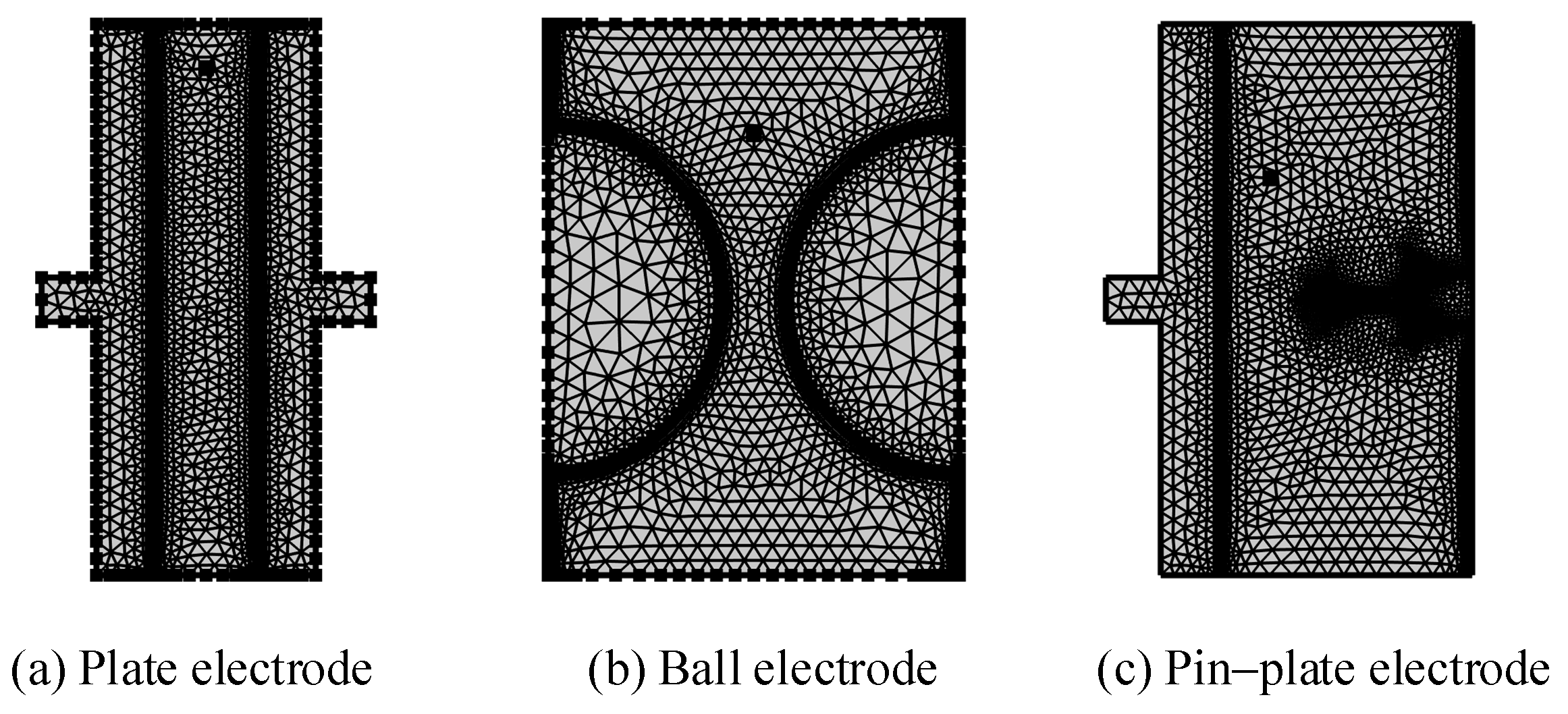

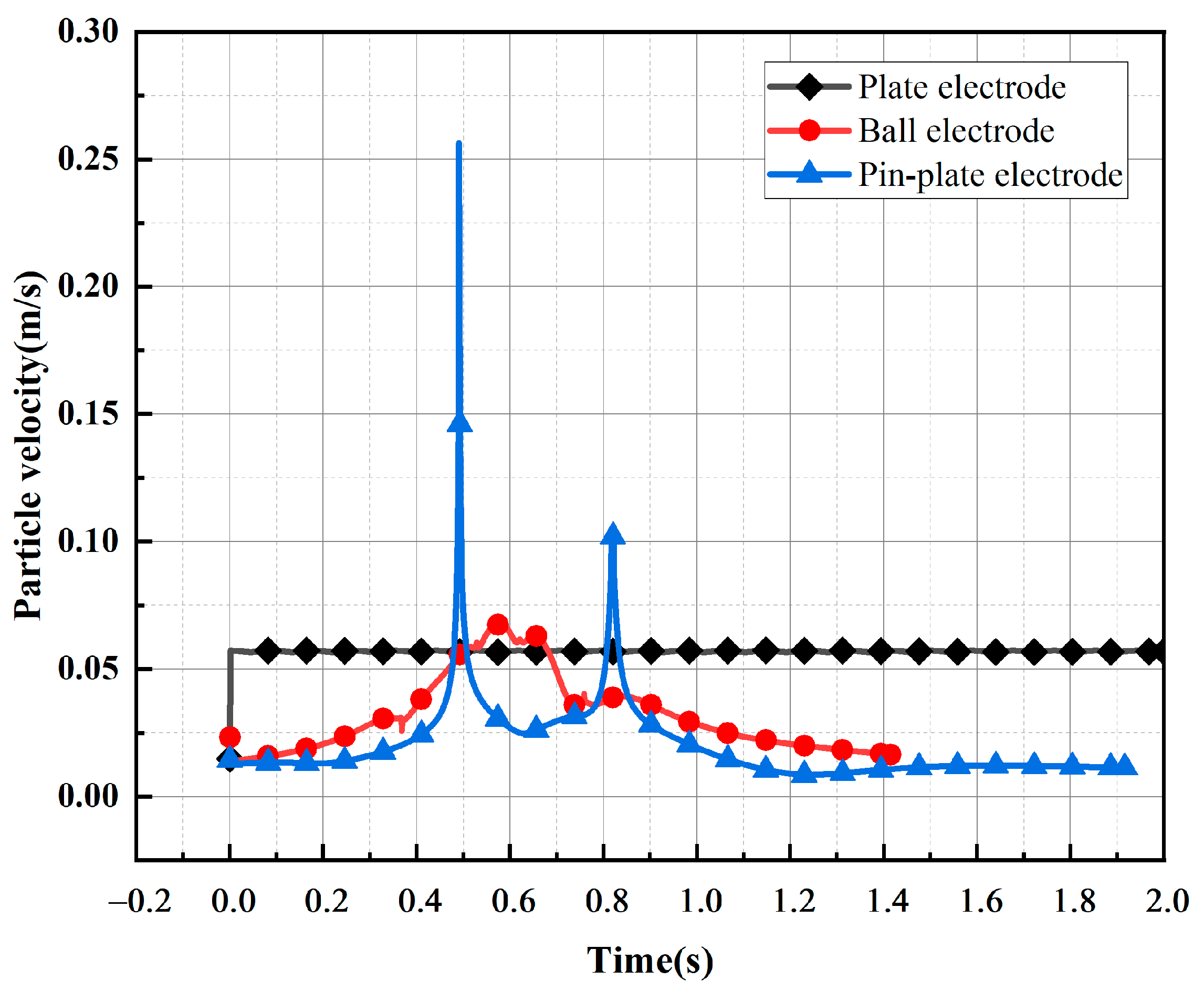



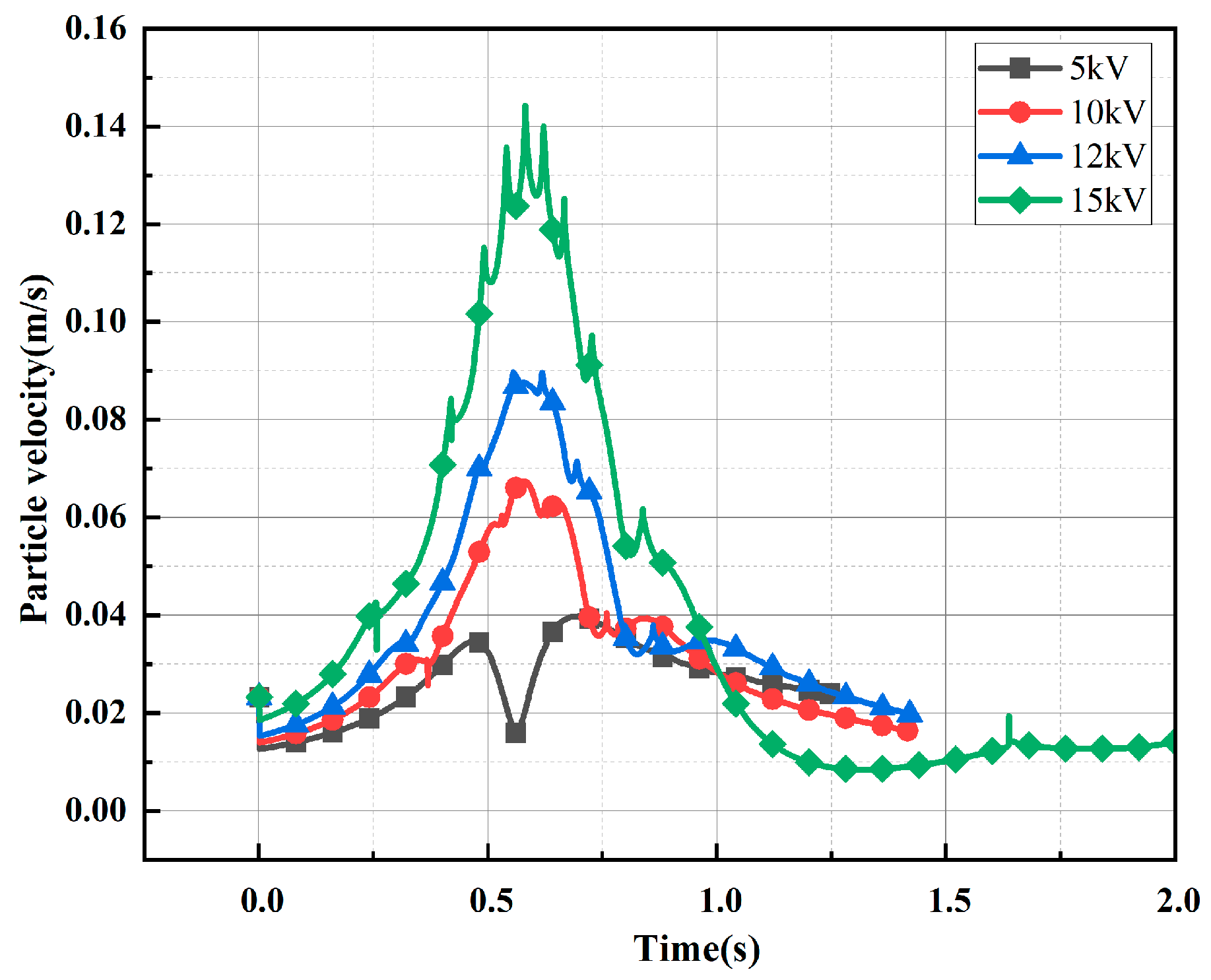


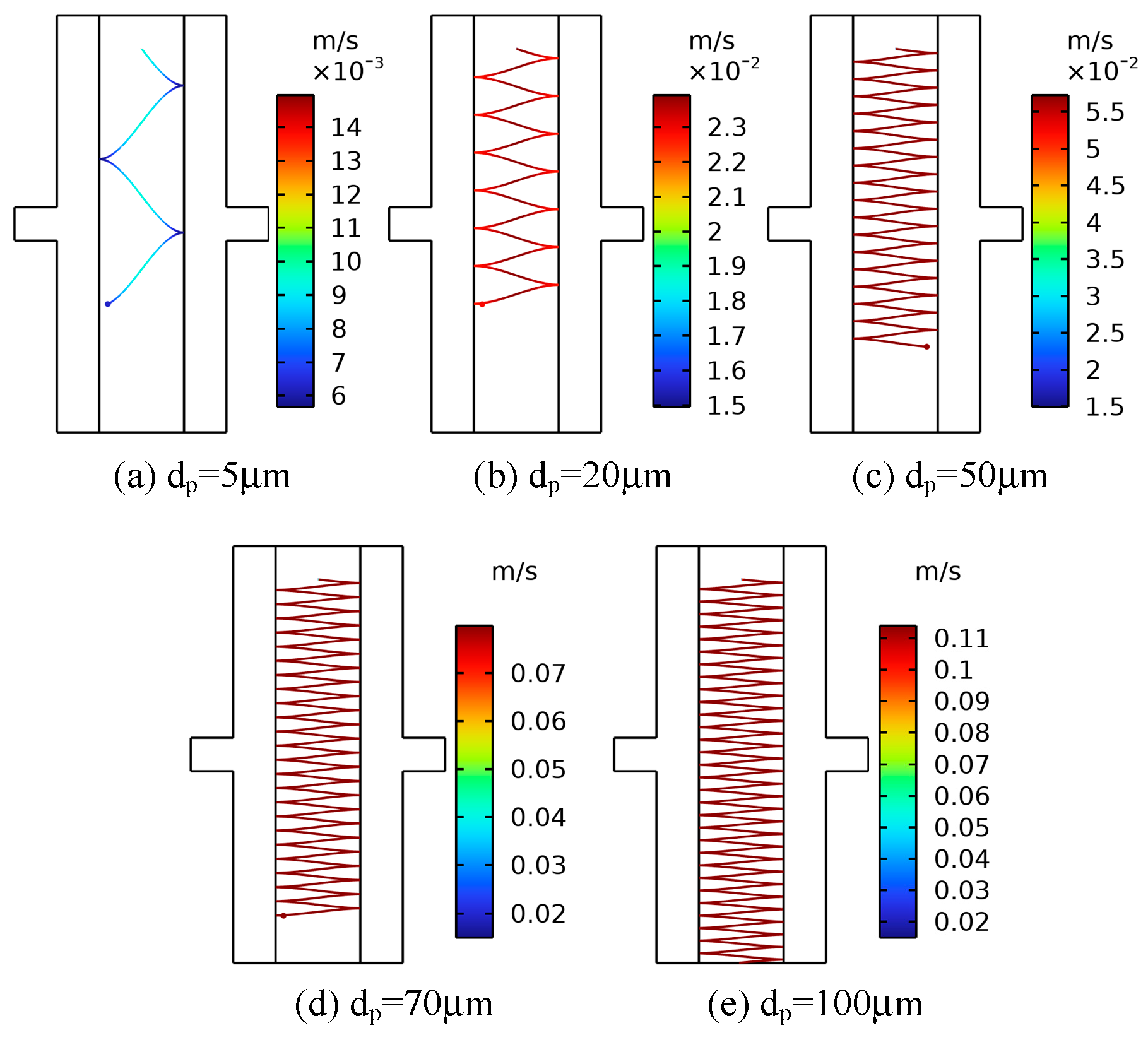

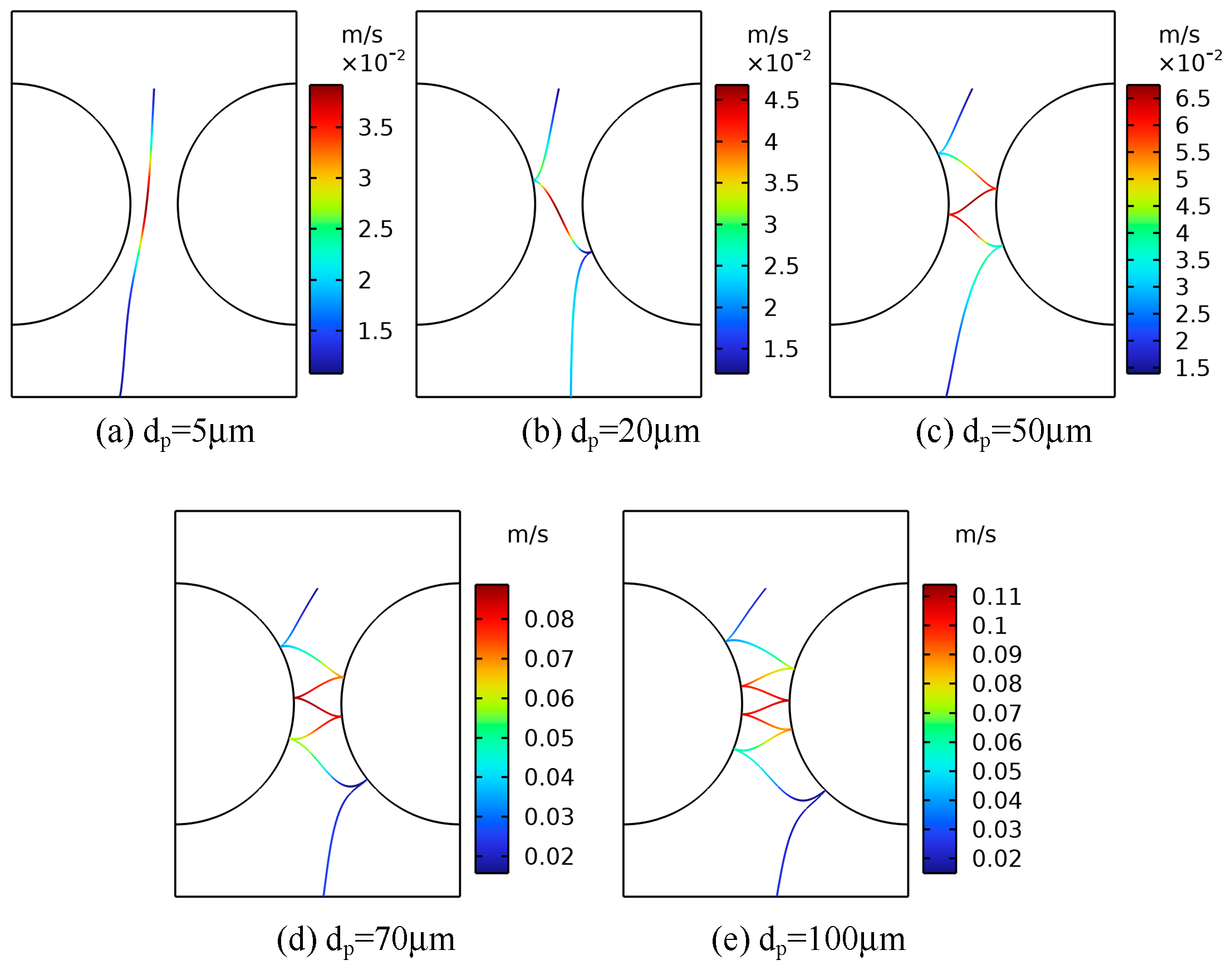


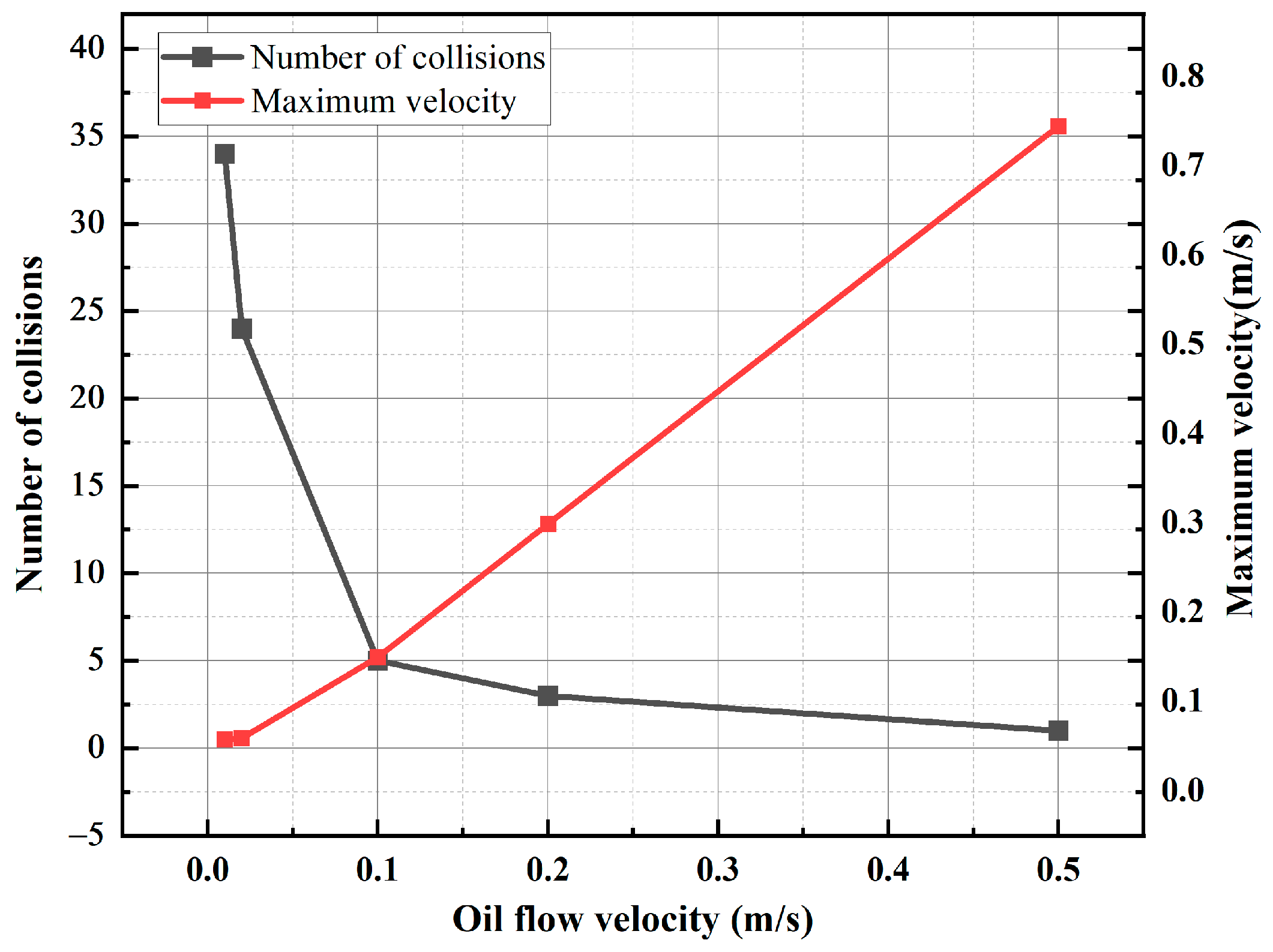


| Type of Force | Source | Numerical Value (N) |
|---|---|---|
| Dragging force (FD) | Fluid motion | 1.92 × 10−5 |
| Magnus force (FM) | Transverse velocity gradient of particles | 1.21 × 10−6 |
| Saffman force (FS) | Transverse velocity gradient of particles | 4.82 × 10−8 |
| Gravity (G) | Particle property | 1.08 × 10−6 |
| Buoyancy (F) | Particle property | 1.18 × 10−7 |
| Electric field force (Fe) | Particle charge and electric field | 8.8 × 10−6 |
| Pressure gradient force (FP) | Pressure gradient | 1.2 × 10−8 |
| Basset force (FB) | Relative acceleration between solids and flows | 10−9–10−7 |
| Additional mass inertial force (FVm) | Relative acceleration between solids and flows | 6 × 10−9 |
| Material Name | Relative Dielectric Constant | Density (g/cm3) | Electrical Resistivity (Ω·m) | Particle Size (μm) |
|---|---|---|---|---|
| Insulating oil | 2.2 | 0.89 | 1013 | — |
| Electrode | 105 | 8.70 | 1.7 × 10−8 | — |
| Metallic impurity particle | 105 | 8.70 | 1.7 × 10−8 | 5~100 |
| Electrode Type | Maximum Motion Speed (m/s) | Average Velocity (m/s) | Number of Collisions |
|---|---|---|---|
| Plate electrode | 0.0573 | 0.0570 | 34 |
| Ball electrode | 0.0674 | 0.0320 | 4 |
| Pin–plate electrode | 0.2565 | 0.0200 | 5 |
| Electrode Grade (kV) | Maximum Velocity (m/s) | Average Velocity (m/s) | Number of Collisions | Time to Axial Boundary (s) |
|---|---|---|---|---|
| 5 | 0.0398 | 0.0266 | 1 | 1.245 |
| 10 | 0.0674 | 0.0320 | 4 | 1.415 |
| 12 | 0.0897 | 0.0394 | 6 | 1.42 |
| 15 | 0.1443 | 0.0352 | 10 | 2.387 |
| Plate Type | Voltage Type | Effective Voltage Value (kV) | Maximum Velocity (m/s) | Average Velocity (m/s) | Number of Collisions |
|---|---|---|---|---|---|
| Plate electrode | Direct current | 10 | 0.0573 | 0.0570 | 11 |
| Alternating current | 10 | 0.0805 | 0.0520 | 0 | |
| AC and DC 1:2 | 22.36 | 0.4325 | 0.2533 | 51 | |
| Ball electrode | Direct current | 10 | 0.0674 | 0.0320 | 4 |
| Alternating current | 10 | 0.0882 | 0.0413 | 0 | |
| AC and DC 1:2 | 22.36 | 0.4318 | 0.1659 | 23 |
| Particle Diameter (μm) | Maximum Motion Speed (m/s) | Average Speed (m/s) | Number of Collisions | Time to Axial Boundary (s) |
|---|---|---|---|---|
| 5 | 0.0392 | 0.0178 | 0 | 1.808 |
| 20 | 0.0468 | 0.0227 | 2 | 1.587 |
| 50 | 0.0674 | 0.0320 | 4 | 1.415 |
| 70 | 0.0887 | 0.0347 | 6 | 1.628 |
| 100 | 0.1282 | 0.0404 | 8 | 1.699 |
| Oil Flow Velocity (m/s) | Maximum Motion Speed (m/s) | Average Speed (m/s) | Number of Collisions | Time to Axial Boundary (s) |
|---|---|---|---|---|
| 0.01 | 0.0674 | 0.0320 | 4 | 1.415 |
| 0.02 | 0.0936 | 0.0568 | 2 | 0.636 |
| 0.1 | 0.3408 | 0.2146 | 0 | 0.149 |
| 0.2 | 0.6566 | 0.4821 | 0 | 0.066 |
| 0.5 | 1.5862 | 1.1790 | 0 | 0.027 |
| Dynamic Viscosity of Insulating Oil (Pa·s) | Maximum Motion Speed (m/s) | Average Speed (m/s) | Number of Collisions |
|---|---|---|---|
| 0.006 | 0.0674 | 0.0320 | 4 |
| 0.01 | 0.0518 | 0.0163 | 3 |
| 0.015 | 0.0486 | 0.0203 | 2 |
| 0.02 | 0.0436 | 0.0196 | 1 |
Disclaimer/Publisher’s Note: The statements, opinions and data contained in all publications are solely those of the individual author(s) and contributor(s) and not of MDPI and/or the editor(s). MDPI and/or the editor(s) disclaim responsibility for any injury to people or property resulting from any ideas, methods, instructions or products referred to in the content. |
© 2024 by the authors. Licensee MDPI, Basel, Switzerland. This article is an open access article distributed under the terms and conditions of the Creative Commons Attribution (CC BY) license (https://creativecommons.org/licenses/by/4.0/).
Share and Cite
Wei, B.; Wang, Z.; Qi, R.; Wang, X.; Zhao, T. A Study on the Motion Behavior of Metallic Contaminant Particles in Transformer Insulation Oil under Multiphysical Fields. Sensors 2024, 24, 5483. https://doi.org/10.3390/s24175483
Wei B, Wang Z, Qi R, Wang X, Zhao T. A Study on the Motion Behavior of Metallic Contaminant Particles in Transformer Insulation Oil under Multiphysical Fields. Sensors. 2024; 24(17):5483. https://doi.org/10.3390/s24175483
Chicago/Turabian StyleWei, Binbin, Zhijuan Wang, Runze Qi, Xiaolong Wang, and Tong Zhao. 2024. "A Study on the Motion Behavior of Metallic Contaminant Particles in Transformer Insulation Oil under Multiphysical Fields" Sensors 24, no. 17: 5483. https://doi.org/10.3390/s24175483





